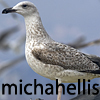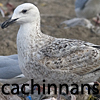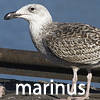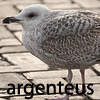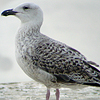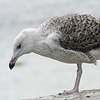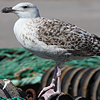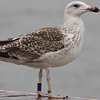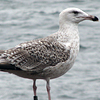 Great Black-backed Gull (Larus marinus)
Great Black-backed Gull (Larus marinus)
(last update: July 12, 2015)
Great Black-backed Gull 2cy October
Plumage sequences in 1cy and 2cy GBBG
The vast majority of Great Black-backed Gull follow a simple, classic moult sequence and moult timing, when compared to other large white-headed gull taxa in Europe. In this respect, it very much resembles Herring Gull. Both Herring and Great Black-backed Gull are nice species to monitor moult, as birds in these taxa replace (most of) the wing-coverts and tertials only once a year.
Only a very small fraction of 1cy Herring and Great Black-backed Gulls (about 2%) replace single coverts in the first autumn, but these exception birds can best be skipped to get a good picture of the normal moult sequences.
plumage 1cy August - 2cy April
The juvenile plumage in GBBG is largely attained until 2cy May; of course scapulars are replaced, but no replacement of coverts and tertials in the post-juvenile moult (autumn 1cy GBBG). This is different from taxa like graellsii, cachinnans and michahellis, where many individuals include the upper tertials and inner wing-coverts in a post-juvenile moult (see 5 example birds below).
The extent of post-juvenile moult in 5 taxa. Images are links: Larus fuscus graellsii (ringed in NW France) 2cy spring, February 12 2007, Agadir, Morocco. Larus michahellis 2cy spring, February 19 2012, Zagreb, Croatia. Larus cachinnans 2cy spring, February 19 2012, Zagreb, Croatia. Larus marinus (ringed in N Russia) 2cy spring February 08 2011, Scheveningen, the Netherlands. Larus argentatus argenteus (ringed in the Netherlands) 2cy spring, February 20 2011, IJmuiden, the Netherlands. |
Throughout the first winter period, marinus and argentatus keep a juvenile wing-covert panel that start to show wear at the fringes in spring. In these taxa, the first new coverts appear in early summer of the 2nd calendar year; covert moult is from May to late August.
plumage 2cy May - 2cy September
In summer all Herring and Great Black-backed Gulls renew all the wing-coverts and tertials for the first time. Most (and, in some birds, all) of these 2nd gen coverts are kept for the next 12 months. This wing-covert moult completely overlaps in time with the complete moult in summer, which starts when P1 is dropped in late-April or early May.
Of course, not all wing-coverts and tertials are shed simultaneously. Moult is initiated at certain loci, and then progresses throughout the entire wing-covert panel.
To completely replace the whole wing-covert panel, it takes about 4 months.
The progress of complete moult in coverts and tertials, in 5 stadia. 1. Normally, the first wing-coverts to be dropped are
innermost greater coverts, innermost median coverts and innermost lower lesser coverts. Then the process speeds up and some birds may have the complete set of central median coverts missing (see link 1). |
The 5 images above illustrate the process of the complete moult in the wing-coverts in the summer months. By August the wing-covert panel and tertials completely exists of 2nd gen feathers. In many birds this does not last very long, as 2cy autumn birds moult a limited set of wing-coverts and again the upper tertials; these feathers then turn into 3rd generation.
plumage 2cy September - 2cy November
By September we often see an extra moult in wing-coverts, which we call a "partial autumn moult" at this website. A partial autumn moult is seen in many white-headed gull species (graellsii, intermedius, michahellis) but Great Black-backed and Herring Gull are best to show what happens. We use "partial" in the definition, as it really is a very limited, yet common process.
For marinus and for argentatus (especially argenteus, far less in nominate argentatus), about 2/3 of the birds have a partial autumn moult in September - November. A limited number of feathers are replaced again, now turning into 3rd generation.
Included are upper tertials, innermost greater coverts, quite some median coverts (sometimes all visible MC) and randomly single lower lesser coverts and lesser coverts. It may be not a surprise that these are exactly the coverts which were replaced early in the complete moult process.
When scoring birds on partial autumn moult, you can fix on specific groups; e.g. in the greater coverts, only the very innermost feathers may be included, at most 4 or 5 feathers. The central and outer greater coverts always remain 2nd generation; only moulted once (late June) and not replaced again before June 3cy.
The partial autumn moult in 2cy GBBG. 1. & 2. 48C 2cy & 3cy, September 02 2008 and March 12 2009, Boulogne sur Mer, NW France. As 2cy in September, moult in coverts and tertials was finished. So how comes we see this bird back in March with many dark median coverts and inner greater coverts? Because a partial autmn moult took place. (see link 1 & 2). |
The pattern on these new 3rd generation feathers is highly variable. Often they very much resemble 2nd gen feathers, and if so, the only way to tell these feathers are 3rd gen, is by the buffish or greyish base. In other birds, the new 3rd gen feathers may appear more adult-like.
Central and outer greater coverts, and most of the lesser coverts as well, are only replaced one time in the annual cycle, they are never include in the partial autumn moult. Probably a very similar partial autumn moult can be found in all white-headed gull taxa, not only in marinus and argenteus. The problem describing such processes accurately lies in the extent of the post-juvenile moult. Marinus and argenteus do not include tertials and coverts in the post-juvenile moult, so we can very much assume where the complete moult starts, and we can easily tell that inner greater coverts and inner median coverts are replaced twice in their 2nd calendar year. But michahellis, graellsii and other taxa have highly variable post-juvenile moult in the wing-coverts, and subsequently it is much more difficult to tell exactly what is going on in summer and autumn. (Is this bird in July replacing the old juvenile feathers, or is it also replacing old 2nd gen feathers from the post-juvenile moult? Hence, will new feathers be 2nd gen or 3rd gen feathers? You just don't know. Only long periods of observations on ringed birds will lead to satisfying conclusions.)
Tables
| Primary moult score of 2cy GBBG L. marinus. Ringed birds in October on this website. | ||
| P8 fully grown | 2 | JA026, 6F3 |
| P9 fully grown | 5 | J1MV, J170W, JA107, JT425, DKC3070781, |
| P10 fully grown | 6 | JP140, JZ0E, JT061, JT508, NOS3020837, P55A |
| n (sample size): | 13 | . |
| m (average): | 9,3 | . |
| SD (stand dev): | 0,75 | . |
Notes: |
||
.
| remaining | 1 |
2 |
3 |
4 |
5 |
6 |
7 |
7 |
8 |
8 |
9 |
10 |
11 |
12 |
| remain/new P | rem |
rem |
rem |
rem |
rem |
rem |
rem |
new |
rem |
new |
new |
new |
new |
|
| n(tot) 213 | jan |
feb |
mrch |
apr |
may |
june |
july |
july |
aug |
aug |
sept |
oct |
nov |
dec |
0 |
. |
. |
. |
. |
. |
. |
1 |
. |
11 |
. |
. |
. |
. |
. |
1 |
. |
. |
. |
. |
. |
. |
. |
. |
8 |
. |
. |
. |
. |
. |
2 |
. |
. |
. |
. |
. |
1 |
3 |
. |
3 |
. |
. |
. |
. |
. |
3 |
. |
. |
. |
. |
. |
8 |
4 |
. |
. |
. |
. |
. |
. |
. |
4 |
. |
. |
. |
. |
2 |
10 |
. |
. |
. |
. |
. |
. |
. |
. |
5 |
. |
. |
. |
. |
4 |
. |
. |
5 |
. |
. |
. |
. |
. |
. |
6 |
. |
. |
. |
1 |
4 |
. |
. |
2 |
. |
6 |
. |
. |
. |
. |
7 |
. |
. |
. |
. |
6 |
. |
. |
. |
. |
13 |
3 |
. |
. |
. |
8 |
. |
. |
. |
. |
2 |
. |
. |
1 |
. |
2 |
4 |
2 |
1 |
. |
9 |
. |
. |
. |
2 |
. |
. |
. |
. |
. |
. |
14 |
5 |
4 |
. |
10 |
31 |
32 |
24 |
5 |
. |
. |
. |
. |
. |
. |
. |
6 |
6 |
7 |
| n= | 31 |
32 |
24 |
8 |
18 |
19 |
8 |
8 |
22 |
21 |
21 |
13 |
11 |
7 |
| average m: | 10,0 |
10,0 |
10,0 |
9,3 |
6,1 |
3,5 |
2,3 |
5,6 |
0,6 |
6,8 |
8,5 |
9,3 |
9,5 |
10,0 |
| 95% CID | 0,00 |
0,00 |
0,00 |
1,16 |
0,61 |
0,29 |
0,87 |
0,89 |
0,32 |
0,27 |
0,34 |
0,45 |
0,46 |
0,00 |
| inverse | 2,04 |
2,04 |
2,07 |
2,36 |
2,11 |
2,10 |
2,36 |
2,36 |
2,08 |
2,09 |
2,09 |
2,18 |
2,23 |
2,45 |
| Variance (s2) | 0,00 |
0,00 |
0,00 |
1,93 |
1,52 |
0,37 |
1,07 |
1,13 |
0,53 |
0,36 |
0,56 |
0,56 |
0,47 |
0,00 |
| SD (s) | 0,00 |
0,00 |
0,00 |
1,39 |
1,23 |
0,61 |
1,04 |
1,06 |
0,73 |
0,60 |
0,75 |
0,75 |
0,69 |
0,00 |
| SE (sx) | 0,00 |
0,00 |
0,00 |
0,49 |
0,29 |
0,14 |
0,37 |
0,38 |
0,15 |
0,13 |
0,16 |
0,21 |
0,21 |
0,00 |
| Percentage | ||||||||||||||
0 |
0 |
0 |
0 |
0 |
0 |
0 |
13 |
0 |
50 |
0 |
0 |
0 |
0 |
0 |
1 |
0 |
0 |
0 |
0 |
0 |
0 |
0 |
0 |
36 |
0 |
0 |
0 |
0 |
0 |
2 |
0 |
0 |
0 |
0 |
0 |
5 |
38 |
0 |
14 |
0 |
0 |
0 |
0 |
0 |
3 |
0 |
0 |
0 |
0 |
0 |
42 |
50 |
0 |
0 |
0 |
0 |
0 |
0 |
0 |
4 |
0 |
0 |
0 |
0 |
11 |
53 |
0 |
0 |
0 |
0 |
0 |
0 |
0 |
0 |
5 |
0 |
0 |
0 |
0 |
22 |
0 |
0 |
63 |
0 |
0 |
0 |
0 |
0 |
0 |
6 |
0 |
0 |
0 |
13 |
22 |
0 |
0 |
25 |
0 |
29 |
0 |
0 |
0 |
0 |
7 |
0 |
0 |
0 |
0 |
33 |
0 |
0 |
0 |
0 |
62 |
14 |
0 |
0 |
0 |
8 |
0 |
0 |
0 |
0 |
11 |
0 |
0 |
13 |
0 |
10 |
19 |
15 |
9 |
0 |
9 |
0 |
0 |
0 |
25 |
0 |
0 |
0 |
0 |
0 |
0 |
67 |
38 |
36 |
0 |
10 |
100 |
100 |
100 |
63 |
0 |
0 |
0 |
0 |
0 |
0 |
0 |
46 |
55 |
100 |
| % Controll | 100 |
100 |
100 |
100 |
100 |
100 |
100 |
100 |
100 |
100 |
100 |
100 |
100 |
100 |
Notes: |
||||||||||||||
 Great
Black-backed Gull (Larus marinus) 2cy J1MV October 15 2008, Boulogne sur Mer, France (50.44 N - 01.35 E). Picture Jean-Michel Sauvage.
Great
Black-backed Gull (Larus marinus) 2cy J1MV October 15 2008, Boulogne sur Mer, France (50.44 N - 01.35 E). Picture Jean-Michel Sauvage. Great
Black-backed Gull (Larus marinus) 2cy JE64 October 19 2006, Boulogne sur Mer, France (50.44 N - 01.35 E). Picture Jean-Michel Sauvage.
Great
Black-backed Gull (Larus marinus) 2cy JE64 October 19 2006, Boulogne sur Mer, France (50.44 N - 01.35 E). Picture Jean-Michel Sauvage. Great
Black-backed Gull (Larus marinus) 2cy JZ0E October 22 2004 Westkapelle, the Netherlands.
Great
Black-backed Gull (Larus marinus) 2cy JZ0E October 22 2004 Westkapelle, the Netherlands. Great Black-backed Gull (Larus marinus) JP140 1CY, 2CY & 6CY, December 2011, October 2012 & October 2016, Boulogne sur Mer, France (50.44 N - 01.35 E). Picture Jean-Michel Sauvage.
Great Black-backed Gull (Larus marinus) JP140 1CY, 2CY & 6CY, December 2011, October 2012 & October 2016, Boulogne sur Mer, France (50.44 N - 01.35 E). Picture Jean-Michel Sauvage. Great Black-backed Gull (Larus marinus) JT061 1CY-2CY, November 2013 & October 2014, Boulogne sur Mer, France. Picture Jean-Michel Sauvage.
Great Black-backed Gull (Larus marinus) JT061 1CY-2CY, November 2013 & October 2014, Boulogne sur Mer, France. Picture Jean-Michel Sauvage.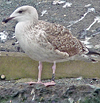 Great Black-backed Gull (Larus marinus) JT425 2CY, October 28 2014, Katwijk aan Zee, the Netherlands. Picture: Frank van der Meer.
Great Black-backed Gull (Larus marinus) JT425 2CY, October 28 2014, Katwijk aan Zee, the Netherlands. Picture: Frank van der Meer. Great Black-backed Gull (Larus marinus) JT508 2nd cycle (2CY), October 20 2014, Castricum, the Netherlands. Picture: Ruud Altenburg.
Great Black-backed Gull (Larus marinus) JT508 2nd cycle (2CY), October 20 2014, Castricum, the Netherlands. Picture: Ruud Altenburg.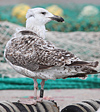 Great Black-backed Gull (Larus marinus) JT811 2CY-3CY, July 2015 - September 2016, Boulogne-sur-Mer, France. Picture: Jean-Michel Sauvage.
Great Black-backed Gull (Larus marinus) JT811 2CY-3CY, July 2015 - September 2016, Boulogne-sur-Mer, France. Picture: Jean-Michel Sauvage.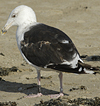 Great Black-backed Gull (Larus marinus) JU153 2CY - 4CY, February 2015 - October 2017, the Netherlands.
Great Black-backed Gull (Larus marinus) JU153 2CY - 4CY, February 2015 - October 2017, the Netherlands. Great Black-backed Gull (Larus marinus) JU754 1CY-3CY, December 2014 - January 2016, IJmuiden, the Netherlands.
Great Black-backed Gull (Larus marinus) JU754 1CY-3CY, December 2014 - January 2016, IJmuiden, the Netherlands. Great Black-backed Gull (Larus marinus) JU811 2CY-3CY, October 2015 - January 2016, Boulogne sur Mer, France. Picture Jean-Michel Sauvage.
Great Black-backed Gull (Larus marinus) JU811 2CY-3CY, October 2015 - January 2016, Boulogne sur Mer, France. Picture Jean-Michel Sauvage.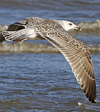 Great Black-backed Gull (Larus marinus) JU999 2CY-3CY, April & October 2016, April 2017, Katwijk, the Netherlands.
Great Black-backed Gull (Larus marinus) JU999 2CY-3CY, April & October 2016, April 2017, Katwijk, the Netherlands. Great Black-backed Gull (Larus marinus) JZ305 2CY, October 20 2015, Boulogne-sur-Mer, France. Picture: Jean-Michel Sauvage.
Great Black-backed Gull (Larus marinus) JZ305 2CY, October 20 2015, Boulogne-sur-Mer, France. Picture: Jean-Michel Sauvage. Great Black-backed Gull (Larus marinus) JZ759 2CY, October 22 2017, Scheveningen, the Netherlands.
Great Black-backed Gull (Larus marinus) JZ759 2CY, October 22 2017, Scheveningen, the Netherlands. Great Black-backed Gull (Larus marinus) JZ883 2CY, October 05 2017, Boulogne-sur-Mer, France. Picture: Jean-Michel Sauvage.
Great Black-backed Gull (Larus marinus) JZ883 2CY, October 05 2017, Boulogne-sur-Mer, France. Picture: Jean-Michel Sauvage. Great Black-backed Gull (marinus) 1cy-2cy NOS 3020837 December 2011 & October 2012, Boulogne-sur-Mer, NW France. Picture: Jean-Michel Sauvage.
Great Black-backed Gull (marinus) 1cy-2cy NOS 3020837 December 2011 & October 2012, Boulogne-sur-Mer, NW France. Picture: Jean-Michel Sauvage. Great Black-backed Gull (Larus marinus) 41P 1CY, October - November 2015, Boulogne-sur-Mer, France. Picture: Jean-Michel Sauvage.
Great Black-backed Gull (Larus marinus) 41P 1CY, October - November 2015, Boulogne-sur-Mer, France. Picture: Jean-Michel Sauvage. Great Black-backed Gull (Larus marinus) 64R 2CY, October 16 2015, Boulogne-sur-Mer, France. Picture: Jean-Michel Sauvage.
Great Black-backed Gull (Larus marinus) 64R 2CY, October 16 2015, Boulogne-sur-Mer, France. Picture: Jean-Michel Sauvage. Great Black-backed Gull (L. marinus) P.55A 2cy, October 31 2013, Boulogne sur Mer, France. Picture Jean-Michel Sauvage.
Great Black-backed Gull (L. marinus) P.55A 2cy, October 31 2013, Boulogne sur Mer, France. Picture Jean-Michel Sauvage. Great
Black-backed Gull NLA 3070781 (Larus marinus) 2cy: October 22 2001,
Westkapelle, the Netherlands (51.33
N, 3.25 E). Primary P10 almost fully grown.
Great
Black-backed Gull NLA 3070781 (Larus marinus) 2cy: October 22 2001,
Westkapelle, the Netherlands (51.33
N, 3.25 E). Primary P10 almost fully grown. Great Black-backed Gull (Larus marinus) 3Y0 2nd cycle (2CY), October 18, 2015, Cape May, New Jersey. Picture: Laura Gaudette.
Great Black-backed Gull (Larus marinus) 3Y0 2nd cycle (2CY), October 18, 2015, Cape May, New Jersey. Picture: Laura Gaudette. Great
Black-backed Gull (Larus marinus) 6F3 2CY, October 04 2010, Nauset Beach, Cape Cod, MA. Picture: Alvaro Jaramillo.
Great
Black-backed Gull (Larus marinus) 6F3 2CY, October 04 2010, Nauset Beach, Cape Cod, MA. Picture: Alvaro Jaramillo. Great
Black-backed Gull (L. marinus) 2cy, October 11 2011, Scheveningen, the Netherlands.
Great
Black-backed Gull (L. marinus) 2cy, October 11 2011, Scheveningen, the Netherlands.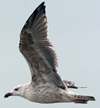 Great
Black-backed Gull (L. marinus) 2cy, October 11 2011, Scheveningen, the Netherlands.
Great
Black-backed Gull (L. marinus) 2cy, October 11 2011, Scheveningen, the Netherlands. Great
Black-backed Gull (L. marinus) 2cy, October 11 2011, Scheveningen, the Netherlands.
Great
Black-backed Gull (L. marinus) 2cy, October 11 2011, Scheveningen, the Netherlands. Great
Black-backed Gull (L. marinus) 2cy, October 11 2011, Scheveningen, the Netherlands.
Great
Black-backed Gull (L. marinus) 2cy, October 11 2011, Scheveningen, the Netherlands. Great
Black-backed Gull (Larus marinus) 2cy: October 01 2001, Le
Portel - Boulogne sur Mer, France (50.42 N - 01.34
E).
Great
Black-backed Gull (Larus marinus) 2cy: October 01 2001, Le
Portel - Boulogne sur Mer, France (50.42 N - 01.34
E).Primary P10 still has to grow a few inches.
 Great
Black-backed Gull (Larus marinus) 2cy: October 01 2001, Le
Portel - Boulogne sur Mer, France (50.42 N - 01.34
E).
Great
Black-backed Gull (Larus marinus) 2cy: October 01 2001, Le
Portel - Boulogne sur Mer, France (50.42 N - 01.34
E).Greater coverts characteristic pattern.
 Great
Black-backed Gull (Larus marinus) 2cy: October 01 2001, Le
Portel - Boulogne sur Mer, France (50.42 N - 01.34
E).
Great
Black-backed Gull (Larus marinus) 2cy: October 01 2001, Le
Portel - Boulogne sur Mer, France (50.42 N - 01.34
E).Primary P9 fully grown.
 Great
Black-backed Gull (Larus marinus) 2cy: October 01 2001, Le
Portel - Boulogne sur Mer, France (50.42 N - 01.34
E).
Great
Black-backed Gull (Larus marinus) 2cy: October 01 2001, Le
Portel - Boulogne sur Mer, France (50.42 N - 01.34
E).Primary P9 fully grown.
 Great
Black-backed Gull (Larus marinus) 2cy: October 01 2001, Le
Portel - Boulogne sur Mer, France (50.42 N - 01.34
E).
Great
Black-backed Gull (Larus marinus) 2cy: October 01 2001, Le
Portel - Boulogne sur Mer, France (50.42 N - 01.34
E).Primary P9 fully grown.
 Great
Black-backed Gull (Larus marinus) 2cy: October 01 2001, Le
Portel - Boulogne sur Mer, France (50.42 N - 01.34
E).
Great
Black-backed Gull (Larus marinus) 2cy: October 01 2001, Le
Portel - Boulogne sur Mer, France (50.42 N - 01.34
E).Primary P10 almost fully grown.
 Great
Black-backed Gull (Larus marinus) 2cy: October 01 2001, Le
Portel - Boulogne sur Mer, France (50.42 N - 01.34
E).
Great
Black-backed Gull (Larus marinus) 2cy: October 01 2001, Le
Portel - Boulogne sur Mer, France (50.42 N - 01.34
E).Primary P10 almost fully grown.
 Great
Black-backed Gull (Larus marinus) 2cy: October 05 2003,
IJmuiden, the Netherlands (52.27 N - 04.33 E).
Great
Black-backed Gull (Larus marinus) 2cy: October 05 2003,
IJmuiden, the Netherlands (52.27 N - 04.33 E).Primary P10 almost fully grown. Partial moult in coverts and tertials.

